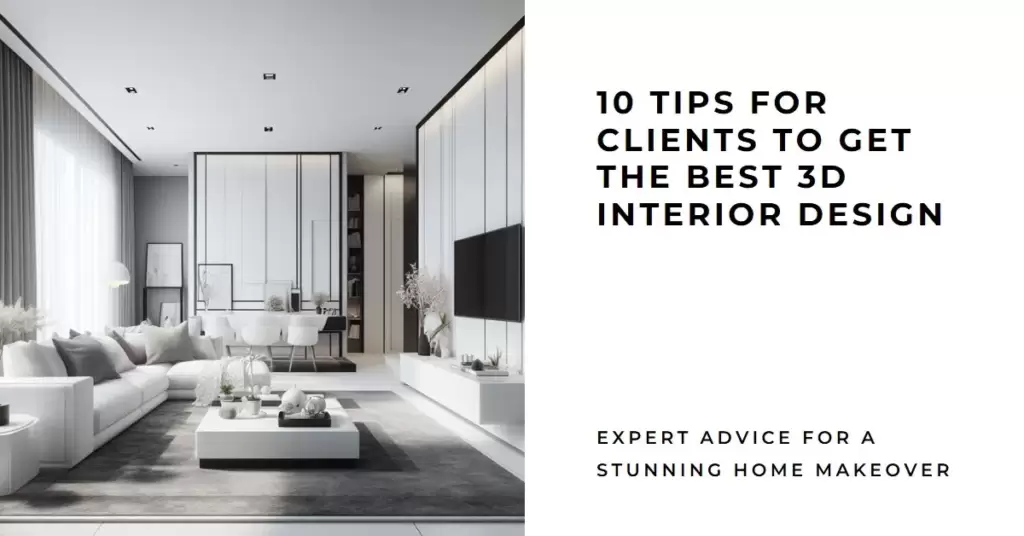
Table of Contents
In the ever-evolving landscape of interior design and customers, the integration of 3D design and Augmented Reality (AR) has emerged as a transformative force. This combination not only elevates the design process but also empowers customers to envision the future of their spaces in unprecedented ways. In this guide, we’ll explore the synergy between 3D interior design and AR, unveiling strategies to help customers embark on a visionary journey.
Section 1: The Fusion of 3D Interior Design and AR
Title: A Seamless Symphony: The Fusion of Virtual and Reality
The marriage of 3D interior design and AR marks a revolutionary shift in how customers interact with and envision their future spaces. 3D design offers a lifelike representation of the proposed interior, capturing every detail with precision. AR takes it a step further by seamlessly integrating these designs into the customer’s physical environment in real-time. This fusion creates a seamless symphony between the virtual and reality, providing customers with an immersive and interactive experience like never before.
The advantages are manifold. Customers can explore different design concepts, experiment with color palettes, and visualize the spatial dynamics of their interiors in real-time. This not only enhances the decision-making process but also fosters a deeper connection to the design, allowing customers to actively participate in shaping their future spaces.
Section 2: Interactive Design Showcases
Title: Virtual Showrooms: Interactive Design Exploration
One of the most impactful applications of 3D interior design and AR is the creation of virtual showrooms. Customers can step into these immersive spaces, virtually navigating through different design concepts and layouts. The interactive nature of AR allows for a tactile exploration, enabling customers to visualize furniture placement, experiment with various styles, and even test different lighting scenarios.
This interactive design showcase goes beyond static images or blueprints, offering a dynamic and engaging experience. Customers can make informed decisions about their preferences, refining their vision along the way. The result is a collaborative and interactive design exploration that bridges the gap between imagination and reality.
Section 3: Real-Time Design Adjustments
Title: Design Evolution on the Fly: Real-Time Adjustments
One of the challenges in traditional interior design is the difficulty of visualizing design adjustments in real-time. With 3D design and AR, customers can witness the evolution of their space on the fly. Whether it’s changing the color scheme, adjusting furniture arrangements, or experimenting with different materials, real-time adjustments empower customers to actively participate in the design refinement process.
This level of immediacy enhances the customer’s sense of control and involvement in the design journey. It also streamlines the decision-making process, as customers can see the impact of changes instantly. Real-time design adjustments transform the interior design experience into a collaborative and dynamic evolution.
Section 4: Personalized Augmented Reality Previews
Title: Your Space, Your Way: Personalized AR Previews
A powerful aspect of 3D interior design and AR is the ability to provide customers with personalized previews of their spaces. Through AR applications, customers can use their smartphones or AR devices to overlay the proposed design onto their actual living spaces. This personalized preview enables them to see how the design aligns with their existing surroundings, ensuring a cohesive and harmonious integration of virtual and real elements.
Customers can walk through their homes with the AR overlay, gaining insights into how the design will function in their day-to-day lives. This personalized touch adds a layer of emotional connection to the design, as customers can envision their unique lifestyles seamlessly integrated into the proposed spaces.
Section 5: Enhanced Decision-Making with AR Visualization
Title: Informed Choices: AR Visualization for Decision Enhancement
Making design decisions can be daunting, but AR visualization transforms the decision-making process into an informed and confident journey. Customers can view different design options in their actual spaces, gauging how each choice aligns with their preferences and needs. This level of visual clarity reduces ambiguity and ensures that customers make decisions based on a comprehensive understanding of the design implications.
From furniture selection to color coordination, AR visualization becomes a powerful tool in the hands of customers. It minimizes the risk of dissatisfaction post-implementation, as customers have already experienced the design in their own environments. Enhanced decision-making through AR visualization paves the way for a more satisfying and successful interior design experience.
Section 6: Collaborative Design Discussions
Title: Design Dialogues: Collaborative AR Conversations
3D interior design and AR facilitate collaborative design discussions between customers and design professionals. Through AR-enabled platforms, both parties can virtually immerse themselves in the design, discussing nuances, exploring alternatives, and refining details in real-time. This collaborative dialogue ensures that the customer’s vision aligns seamlessly with the designer’s expertise, fostering a dynamic and iterative design process.
AR-enabled design discussions transcend traditional boundaries, allowing for instantaneous feedback and adjustments. The result is a design that harmonizes the creative aspirations of the customer with the technical insights of the design team. Collaborative design dialogues become a cornerstone in the co-creation of spaces that truly reflect the customer’s unique vision.
Section 7: Overcoming Design Misalignments
Title: Alignment Assurance: Overcoming Design Discrepancies with AR
Misalignments between customer expectations and the final design are common challenges in interior design. 3D design and AR serve as powerful tools to overcome these discrepancies. By providing customers with immersive experiences and real-time adjustments, potential misalignments can be identified and addressed during the design phase, mitigating the risk of dissatisfaction post-implementation.
AR allows customers to view the design from multiple perspectives, ensuring that every aspect aligns with their expectations. The ability to spot and resolve design misalignments in real-time ensures a smoother and more satisfying design journey for customers. Alignment assurance becomes a proactive approach to delivering designs that surpass customer expectations.
Section 8: Seamless Integration of AR Technology
Title: Tech Fusion: Seamlessly Integrating AR into Interior Design
For customers to fully harness the benefits of 3D interior design and AR, seamless integration of technology is paramount. Design professionals should ensure that the AR applications are user-friendly, compatible with various devices, and capable of delivering high-quality, realistic visualizations. The goal is to make the technology an intuitive and accessible tool that enhances the overall customer experience.
Additionally, providing adequate training and support for customers to navigate the AR applications ensures a smooth transition into the world of augmented design. The seamless integration of AR technology into interior design not only expands the creative possibilities but also empowers customers to actively engage in the visualization process.


Section 9: Future-Proofing Your Interior Design Experience
Title: Future Horizons: Elevating Interior Design with 3D and AR
As technology continues to advance, the synergy between 3D interior design and AR opens up limitless possibilities for the future. Design professionals and customers alike should embrace this evolution, recognizing that the integration of technology not only enhances the design process but also future-proofs the interior design experience. As AR capabilities evolve, so too will the ways in which customers can engage with and envision their spaces.
Staying informed about emerging technologies, updates, and trends in 3D interior design and AR ensures that both designers and customers remain at the forefront of the industry. The future horizon holds the promise of even more immersive, interactive, and personalized interior design experiences that redefine the boundaries of creativity.


